


Blockchain technology enters an increasing number of industries that were not previously associated with it, from FinTech to healthcare and education. According to Harvard Business Review, blockchain is believed to be a secure and efficient technology for automating business processes, asset protection, and verification of transactions. Creating an application based on blockchain technology can be a tedious task. To help you with it, we have made a complete guide covering all stages of blockchain application development and its potential costs. Explore how to develop a blockchain app with Purrweb.
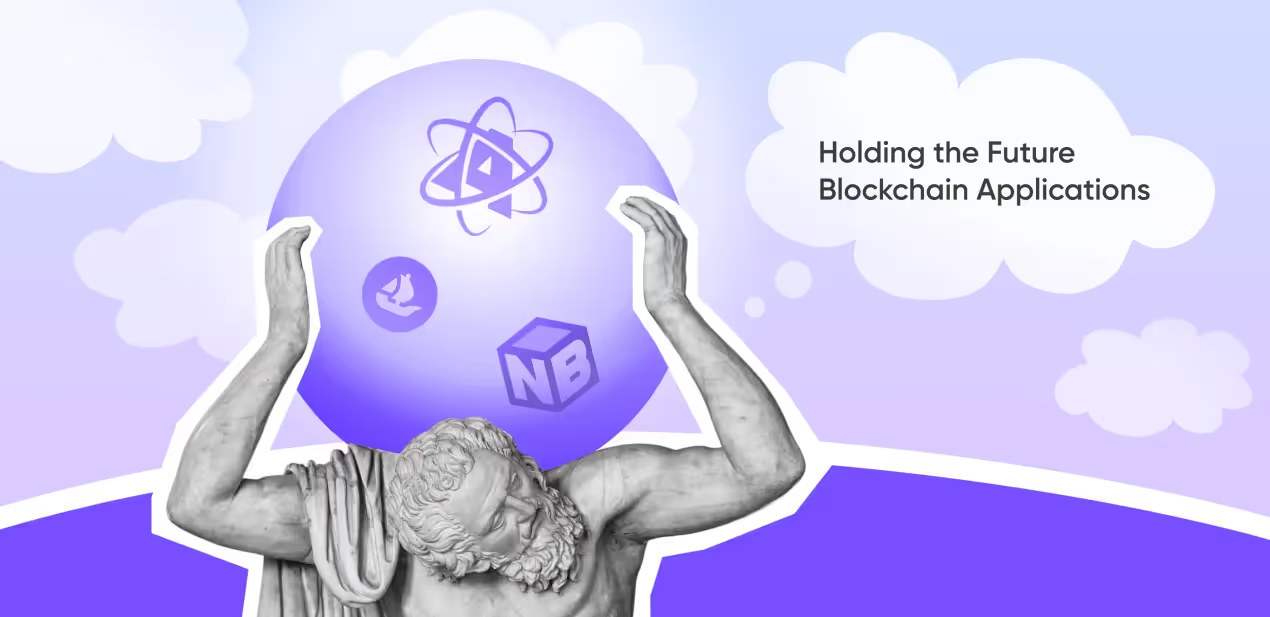
First, let’s look at the blockchain itself. A blockchain is a network that stores the data received into it in chronological order in blocks. As soon as a transaction occurs on the blockchain network, it appears in the public domain of all network participants. Blocks of data are stored in a chain, and once they are added there, they cannot be changed. This makes the blockchain extremely difficult to breach and corrupt data.

Blockchain applications are often referred to as decentralized applications, or DApps. DApps are based on the blockchain and have their unique features different from traditional apps. These are applications built on peer-to-peer decentralized networks. There is no centralized entity or single point of failure on the blockchain that would play the role of intermediary between users exchanging data or money.
In the development process of a traditional, centralized app, you need to run the backend code on centralized servers. Unlike the ordinary apps, decentralized applications run their backend code in a peer-to-peer network.

From the user’s point of view, blockchain applications look just like traditional applications. So this technology doesn’t intimidate people and we use them as ordinary apps, but having all the advantages of working with blockchain.
Let’s look at the unprecedented introduction of blockchain technologies in figures and statistics.
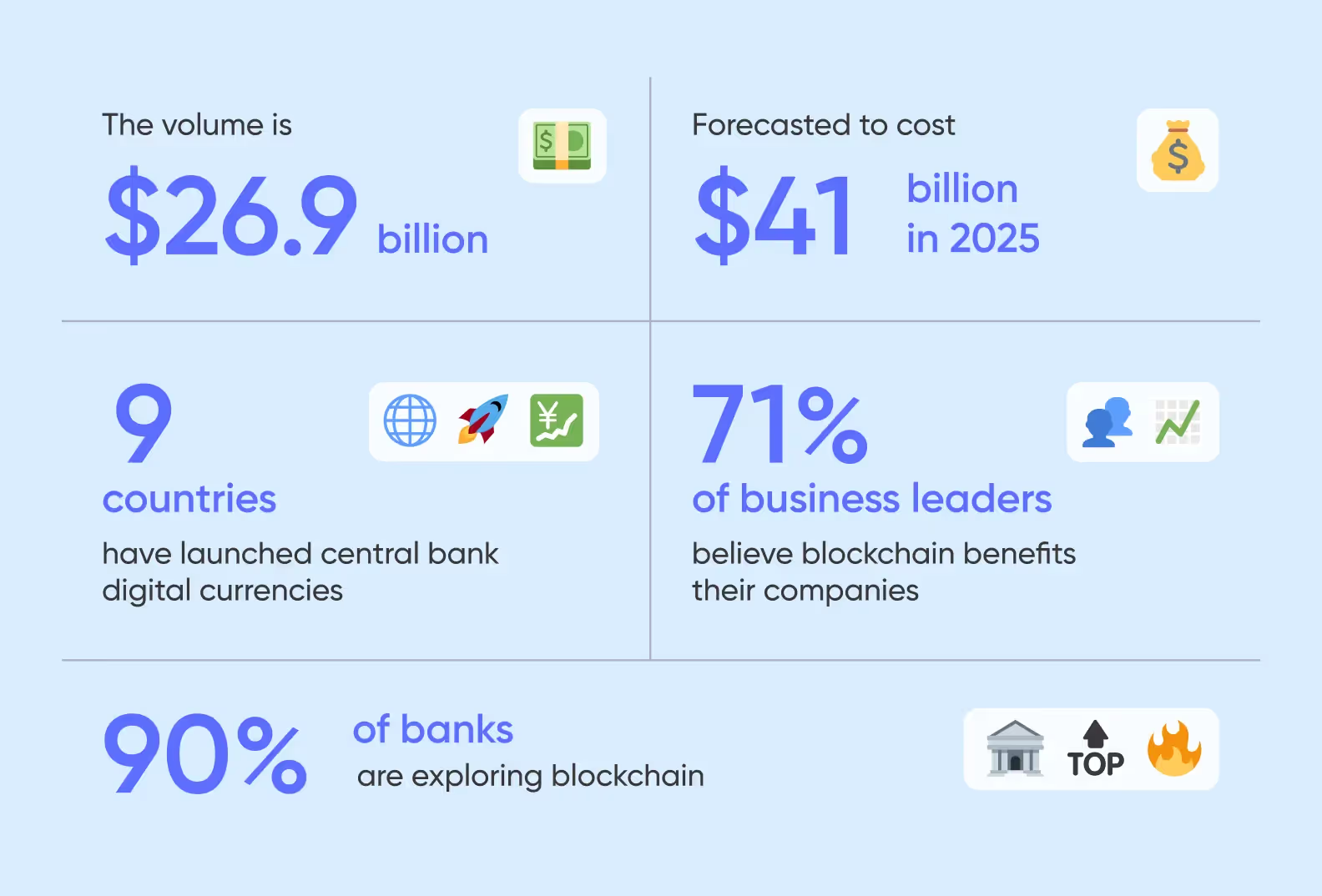
The most popular blockchain app development platform is Ethereum since it offers smart contracts that are commonly used for DApp development. Looking at the performance of this technology and overall blockchain app trends, we can assume that blockchain software development now is a promising idea.
As we have already found out, blockchain is a useful modern technology that can serve in many industries such as banking, logistics, and business. There are many applications competing in the number of participants and, to stand out from the competition, developers are implementing new blockchain solutions. Let’s look at specific narrow areas where blockchain can be applicable.
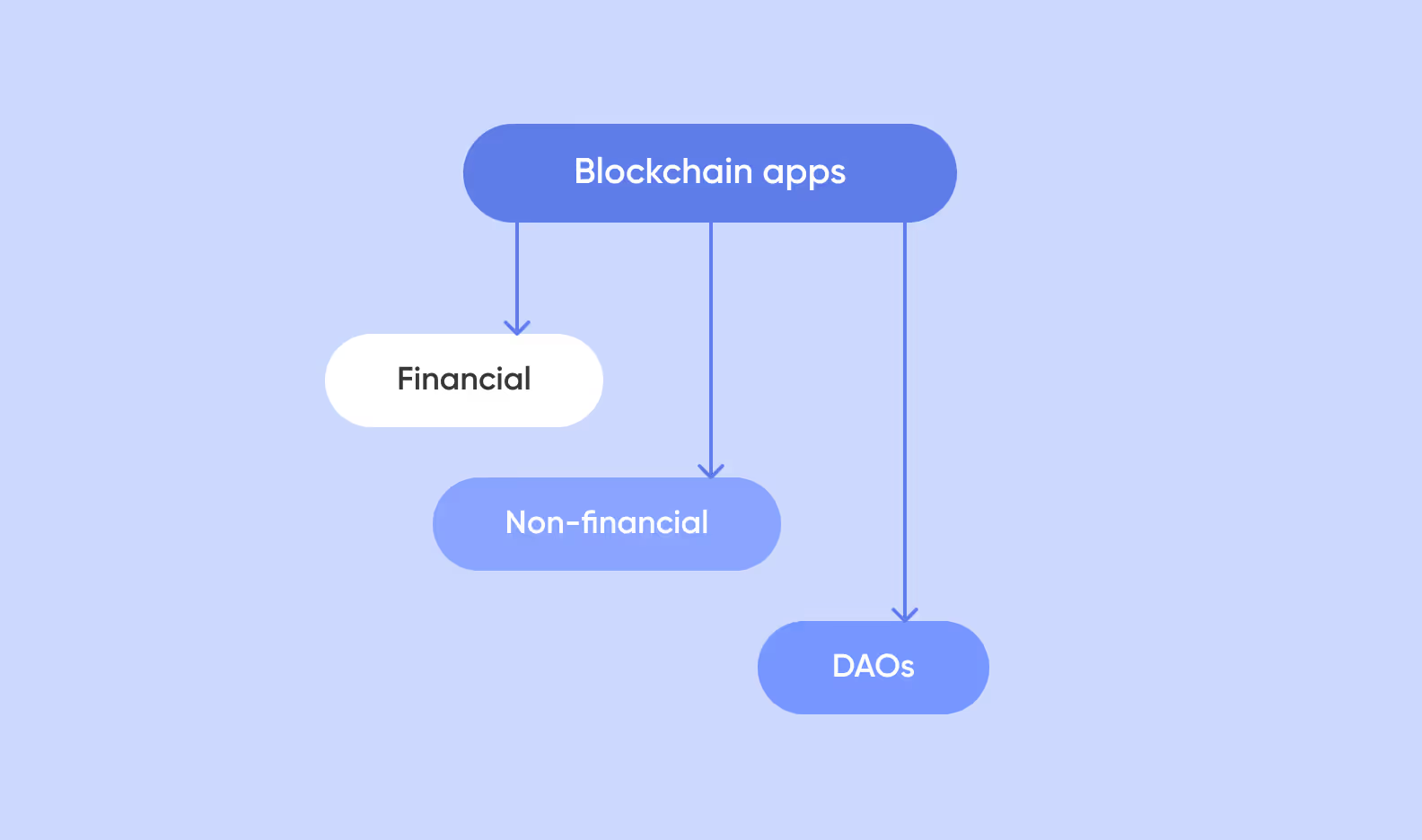

DeFi applications, short for “decentralized finance“, are tools for making monetary transactions. These include decentralized exchanges, exchange services, and other applications and blockchain platforms designed to interact with cryptocurrency. The most common types are:
Auctions. Transparency is a determining factor for conducting online auctions. DApps make it possible to guarantee the invariability of bids and strictly fix the time they were made, eliminating the possibility of any manipulations. Therefore, online auctions are a promising segment for blockchain applications. Auctions can work with non-fungible tokens, allowing the creation of auctions and placing bids in real time.
Prediction Markets. Prediction markets are stock exchanges where the objects of trading are not goods, but the results of various events, such as sports games or even presidential elections. Let’s draw an analogy with a futures contract: when trading futures, you also bet on the rise or fall of the asset price. DApps allow users to make their predictions on the market, and not just vote for events offered by the blockchain platforms.
Gaming and gambling. Thanks to the trend of creating play-to-earn (p2e) blockchain games, where users can receive tokens with real value while playing, gaming and gambling can classify as a part of DeFi. Using DApps, users can avoid the opacity of purchasing in-game assets and the lack of user control over their bids. Now blockchain games ensure reliable storage of users’ funds.
There is a long-lasting uptrend for game blockchain development: DApps often occupy the top places in the rating of popular blockchain applications. The trend began several years ago, when one of the first games, CryptoKitties, was released on the Ethereum platform.
Non-financial applications have nothing to do with money transfers. One of the most common types is applications for user identification.
User identification services. They are becoming more and more relevant with expanding remote services, for example, online banking. Decentralized applications provide secure and reliable storage of user data. Using a DApp, only you will have access to your data, the information will be securely encrypted, and for anonymity, you will be provided with a unique address or ID number. From the point of view of the organization, transparency and honesty are established during identity verification, because one user cannot create several verified KYC profiles.
Sharing disks or computing power services. There are autonomous data storages and communications networks, which provide users with tokens that can be exchanged or received in exchange only for disk space or computing power. Among the main advantages are anonymity, transparency, and security. The SAFE Network was the first service of such a type; it uses Safecoin tokens, which are not sold anywhere.
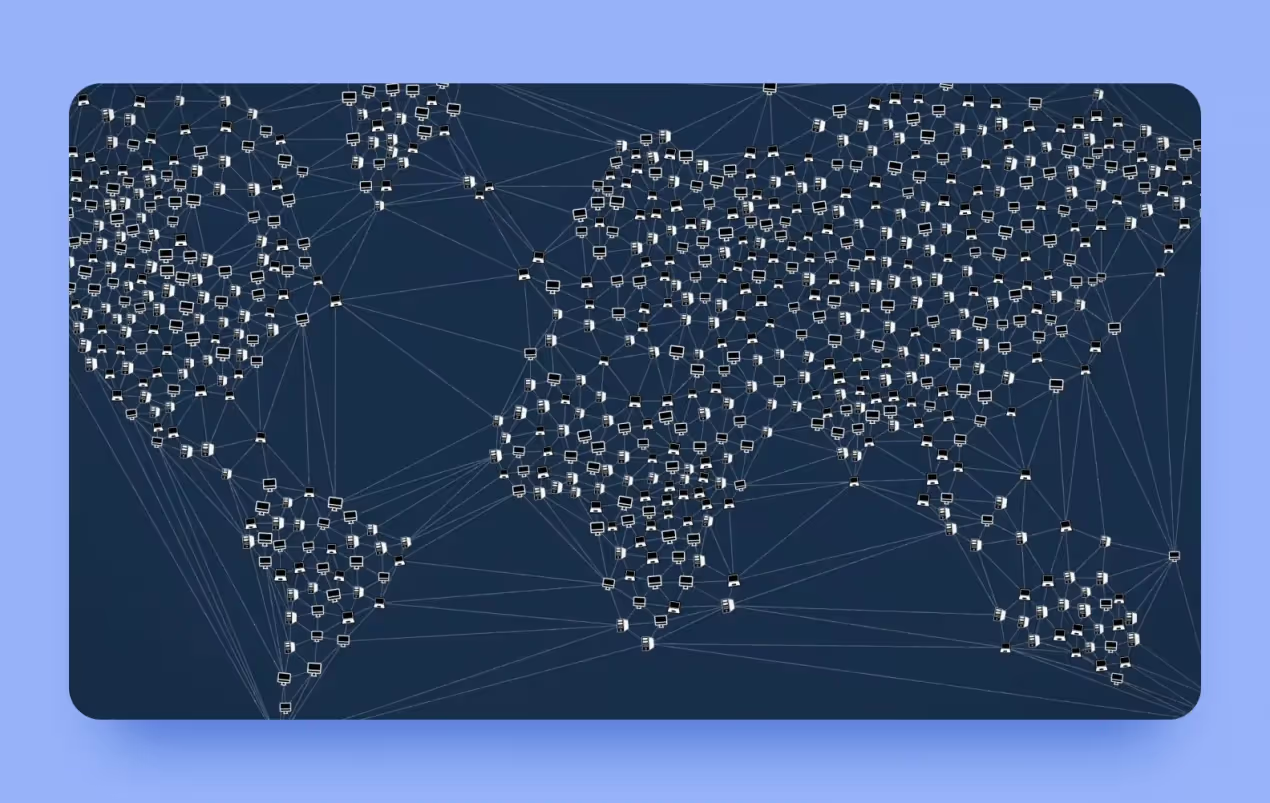
Decentralized autonomous organizations (DAOs) are particularly ambitious DApps in the crypto world. Their goal is to form a company without a leader. They program rules on how members can join, vote, or issue company funds in the development stage. In the crypto industry, DAO’s operation is based on smart contracts, that’s why the infrastructure for DAO appeared thanks to Ethereum.
It is important to note that a DAO is not a platform, but a management system. For example, it is wrong to call Uniswap crypto exchange the DAO, but its decentralized management system is the DAO. Automation of management helps to get rid of a huge staff, lawyers, and accountants, as well as to minimize the human factor and corruption.

If you are interested in any of the types of applications, we can share an expert opinion on its development. Purrweb’s team knows how to build decentralized applications, including data transfer apps, cloud storage, marketplaces, and much more that is connected to the decentralized system and requires writing smart contracts. We also have experience working with crypto wallets, which you can check out here.
According to the data of DappRadar, the most popular applications by the number of users belong to the gaming sector. Let’s check out their features.
Alien Worlds is an NFT Metaverse built on the WAX blockchain where users can play with non-fungible digital collectibles. The platform offers staking — receiving rewards for placing funds in a blockchain wallet for a certain time, and unique Planet DAOs — decentralized autonomous organizations with client portals. There are also trading opportunities using game cards.

PancakeSwap is a decentralized exchange (DEX) based on Binance Smart Chain (BSC), launched by Binance in September 2020. On the platform, users can trade, earn, and win cryptocurrency. The exchange has more than $4.1 billion in funds and regularly hits the headlines.

Splinterlands was launched on March 25, 2021, and has rapidly gained more than 185k users. This play-to-earn game also actively uses unique in-game assets, which can be traded and exchanged. The users collect card decks and participate in battles or convert cards to crypto.
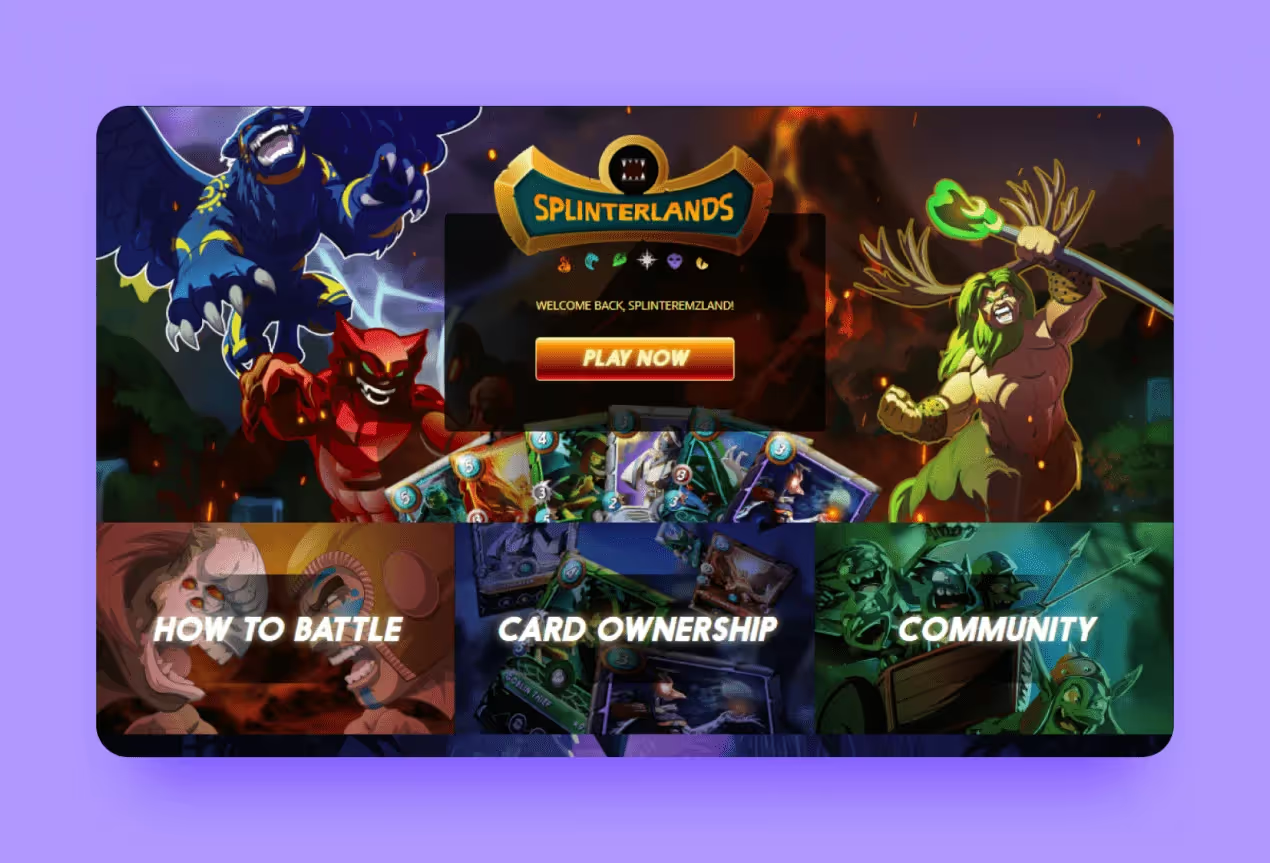
You can find more recent industry news in the DappRadar Blockchain Industry Report.
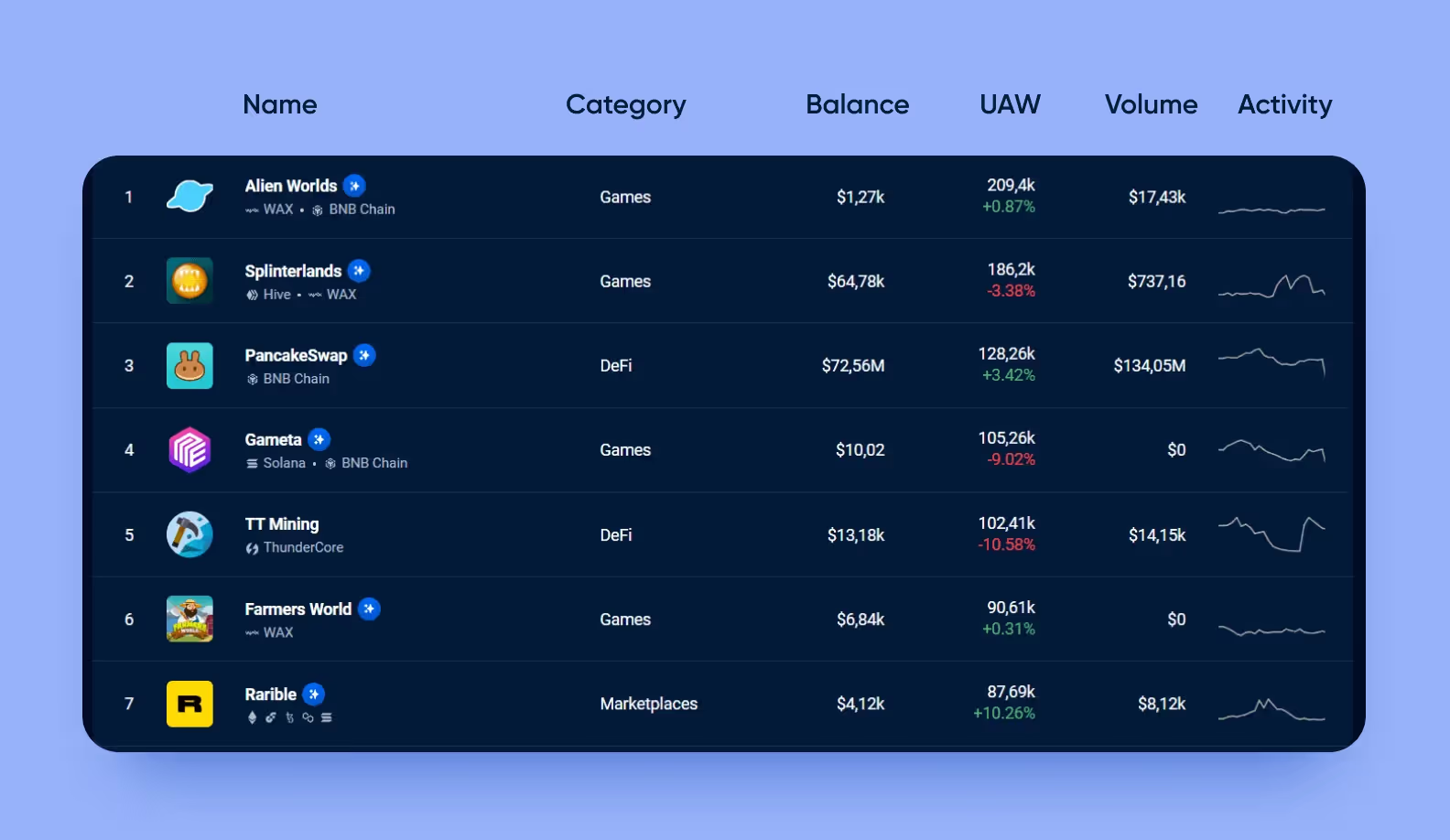
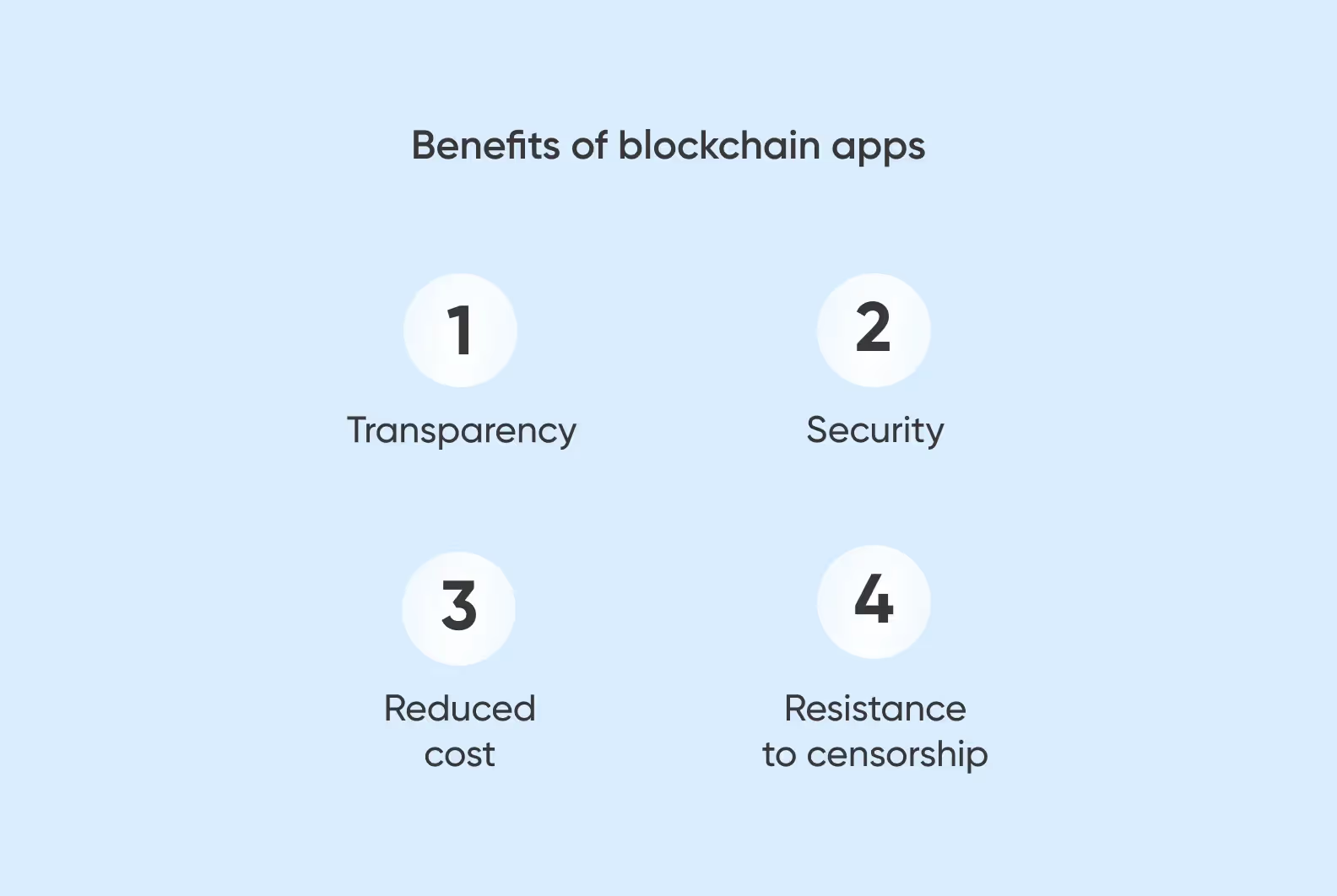
Blockchain applications bring tangible value, namely, they reduce business operational costs and increase users’ security and autonomy. Users gain more control over their finances and personal data, as they do not need to trust someone else to store and protect their information. Let’s consider the major benefits of blockchain apps that will gain users’ attention.
Users can learn how a blockchain application works any time they want because of the transparency of the system. Everything is saved in the open ledger, it is clear, and this is often one of the main reasons for choosing such apps. For example, the development of a blockchain application can help two companies interested in cooperation to reach a new level without additional overheads.
A DApp is by default more secure than any conventional app, simply because of the core blockchain technology functions. Blockchain implementation brings strict encryption and safety mechanisms that prevent data erasure or forgery, and any update of the application requires the agreement of all users of the application.
The blockchain-based application aims at enhancing business processes by eliminating any intermediaries and third parties from the work processes. A vivid example are peer-to-peer transactions — payments that users make directly to one another using a payment service. Consequently, the cost of offering the same services is reduced when using fewer resources.
Without unified management, it is challenging for the government or influential individuals to control the network. It will also not be possible to influence the mechanisms programmed in advance from the outside. Thus, censorship in the application is not possible.
What you need to consider when developing an application, is that the result hugely depends on the instruments, platforms, and technologies you choose. But how to build blockchain application in the most efficient way?
It’s better to start blockchain application development by selecting a network, which supports DApps, and comparing the advantages and disadvantages of the available networks. There are 4 basic factors you need to carefully choose:
To develop a blockchain based application, you will need to choose a desktop, a web or a mobile option. Let’s explore some advanced technologies and programming languages that can be used for different app types.
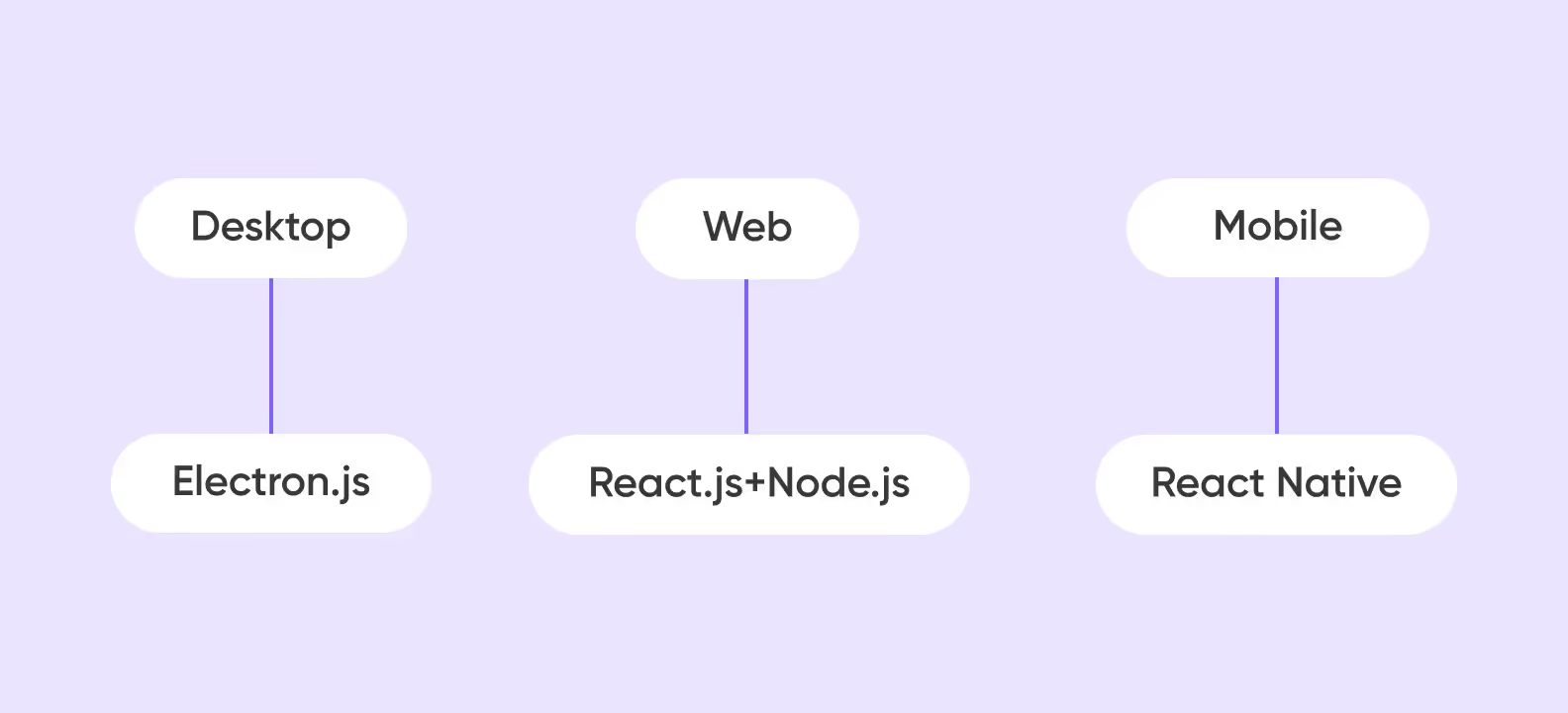
Electron.js for desktop apps. Electron.js is an open-source framework that helps to create native cross-platform applications for desktops using JavaScript, HTML, and CSS. It uses Chromium and Node.js. Electron.js apps are compatible with Mac, Windows, and Linux.
React.js and Node.js for web apps. These are JavaScript libraries for web applications. Node.js is a backend development environment that is used to build scalable and highly flexible web applications with high performance. React is an open-source frontend library for creating user interfaces with a convenient developer toolset.
React Native for mobile apps. React Native is used to create mobile apps for Android and iOS. Using a single code base, this framework helps develop applications for both platforms with only one team, to save time and money on the blockchain application development.
Remember that you need to write smart contracts on the back. The best programming languages for decentralized applications are Solidity, Java, Python, JavaScript, SQL, and others. Not just any coder will develop a DApp, as blockchain development is quite specific. This is their difference from the regular applications. At Purrweb, we can work it out.
OK, but how do you actually create an app? Here’s the entire blockchain app development process conveniently divided into 5 steps — from market analysis to post launch support.
Start off by carefully researching your competitors to identify their strengths and weaknesses. Analyze their features, pricing strategies, and positioning — this will help you identify gaps in the market that you can use to your advantage, as well as flesh out the concept of your future product. Don’t forget to scroll through some customer reviews: if you look closely enough, you can gain some valuable insights about client experience.
Then, gather as much data as you can about the present state of the market. Pay special attention to your niche, focusing on defining both current and emerging trends. This information indicates the overall direction of the field, and applying it correctly can also help you quickly build a customer base.
Last but not least, try to be as specific as possible when talking about your target audience. Consider building customer personas — generalized representations of the people who are going to be interested in your product. To create a persona, conduct several in-depth interviews and organize the obtained information into the following blocks:

Step two: take your business idea and refine it using the information you’ve obtained during market research. Pin down the problem that you want to solve and decide how exactly your app is going to surpass rival apps in doing so. Maybe it’s going to vastly improve a popular formula? Or pioneer a completely different approach? Or both? Whatever you choose, keep in mind that simply copying successful solutions is not enough — you also have to bring something new to the table.
Once you have clear answers to these questions, we highly recommend committing them to paper — or, in other words, drawing up a business plan. It’s a useful tool that will help you determine the overall direction of the startup, not to mention that having this document is absolutely crucial if you want to win over investors and other stakeholders. Later on, you can also use it to outline a thorough financial strategy, evaluate your product’s performance, establish clear goals and keep the team in sync. A useful thing through and through!
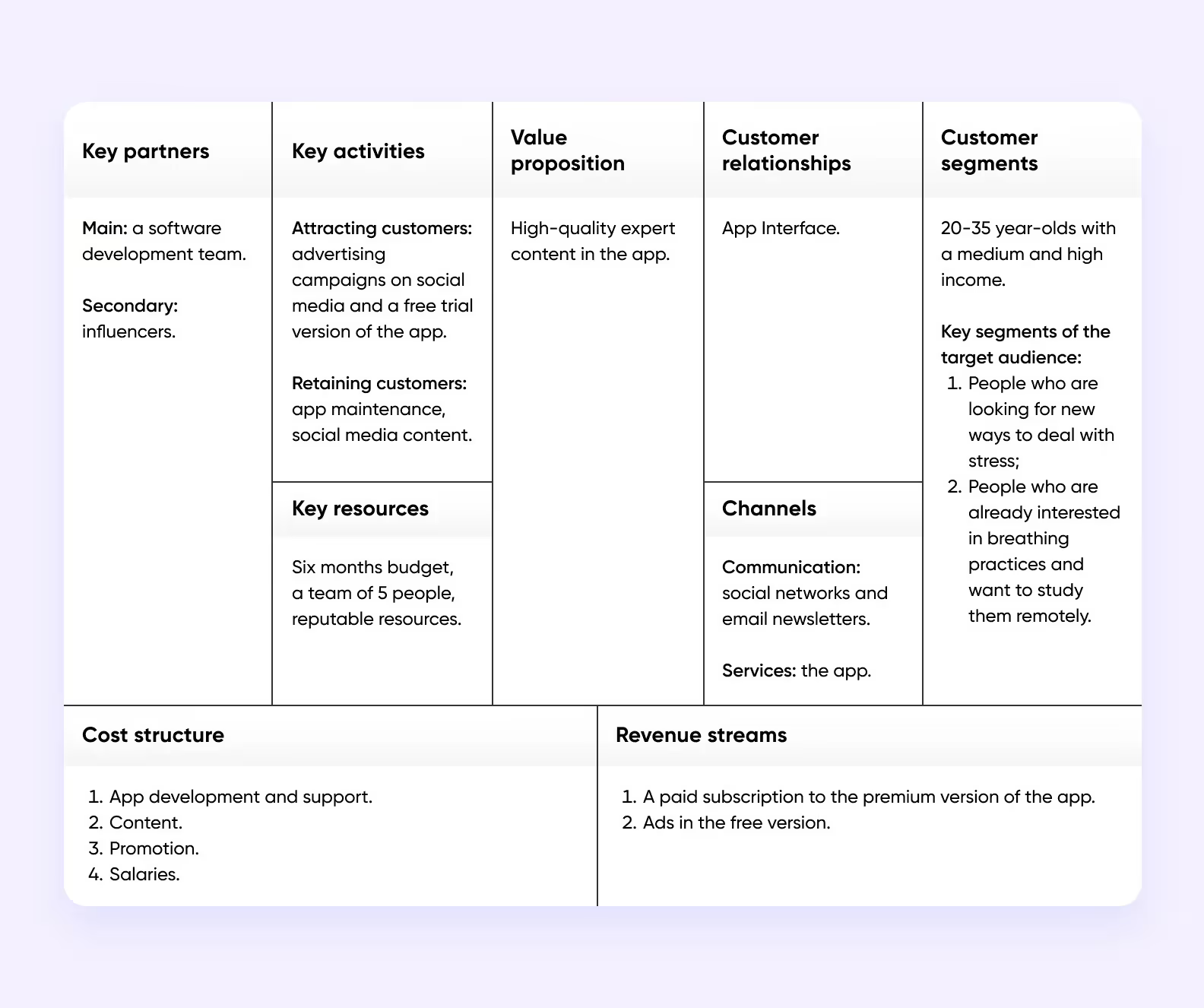
Since we’re talking about blockchain, there’s a lot of advanced tech to take care of. At this stage, you need to come up with the app’s architecture, which includes consensus mechanisms, blockchain networks, and other technical nuances. This is a lot to cover — there’s enough material for an entire article. But to give you a starting point, let’s look at some of the most popular consensus mechanisms:
Here’s how we approach UI/UX design at Purrweb. We begin with project evaluation, studying the specifics of your project and gathering references — both positive and negative. Our designers then develop blockchain UX design: they use this information to define the logic of the app, creating a mindmap that will outline the user flow and serve as a set of guidelines for future work.

After that, we move on to wireframes. These are the first sketches of the design. They are immensely helpful: we need them to outline the general flow of the screens and decide what content and features they should include. Once the wireframes are ready, we send them over to you to get some feedback. When you give your final approval, we move on to the next stage — graphic design.
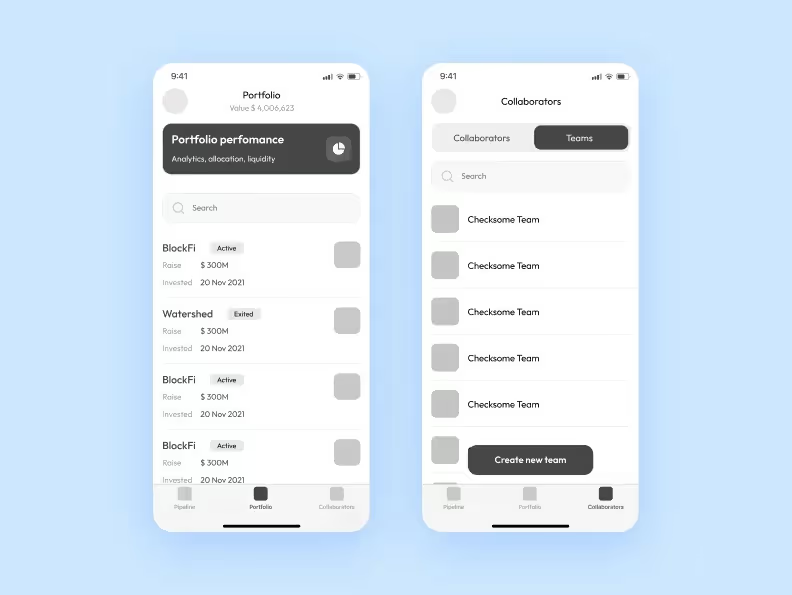
Wireframes establish the basic structure of the screens; graphic design defines how they look and feel. We choose colors and fonts, create icons and illustrations, animate stuff, design UI components — and make sure that the app looks equally fantastic on all platforms, devices, and screens. To maintain consistency, we merge everything into a unified UI kit, which also makes it much easier to implement new features and screens later on.
Purrweb is a full-cycle agency, so our development team can take over the project once the designers finish creating the interface. We’ll write the code, conduct thorough testing and provide post-launch support for as long as you want. In our work, we use an iterative, Scrum-based approach that allows us to quickly adapt to any conditions, provide transparency in every process and massively reduce the costs of development.
The stack we use is mostly centered around JavaScript frameworks.
These frameworks come with built-in performance optimization features and are perfectly suitable for building scalable applications for all platforms. They also come with extensive ecosystems of plugins, extensions, and third-party libraries that we can easily integrate into your project to significantly boost the speed of development. Here’s a closer look at the technologies we use daily:
We have a couple blockchain apps in our portfolio. Let us tell you a bit more about these projects.
A little while back we got a request from the creators of Broex, a multi-currency crypto wallet with a European license. Our clients had already launched the browser version, but then suddenly encountered difficulties with the mobile one: the App Store just kept rejecting it. Our task was to develop a cross-platform application for iOS and Android while avoiding the mistakes of the previous team.
In terms of design style, we turned to classic financial apps for inspiration. Their style is more familiar to beginners and just easier to comprehend. To perfect the UI, we developed a custom currency selector that opens from the bottom of the screen.
And now the real challenge: we had to work with a backend written by another team, while also being unable to make any changes to it. Oh, and it was web-oriented, too. But it didn’t stop us — we solved all the problems that arose and handed the app in without any delays.
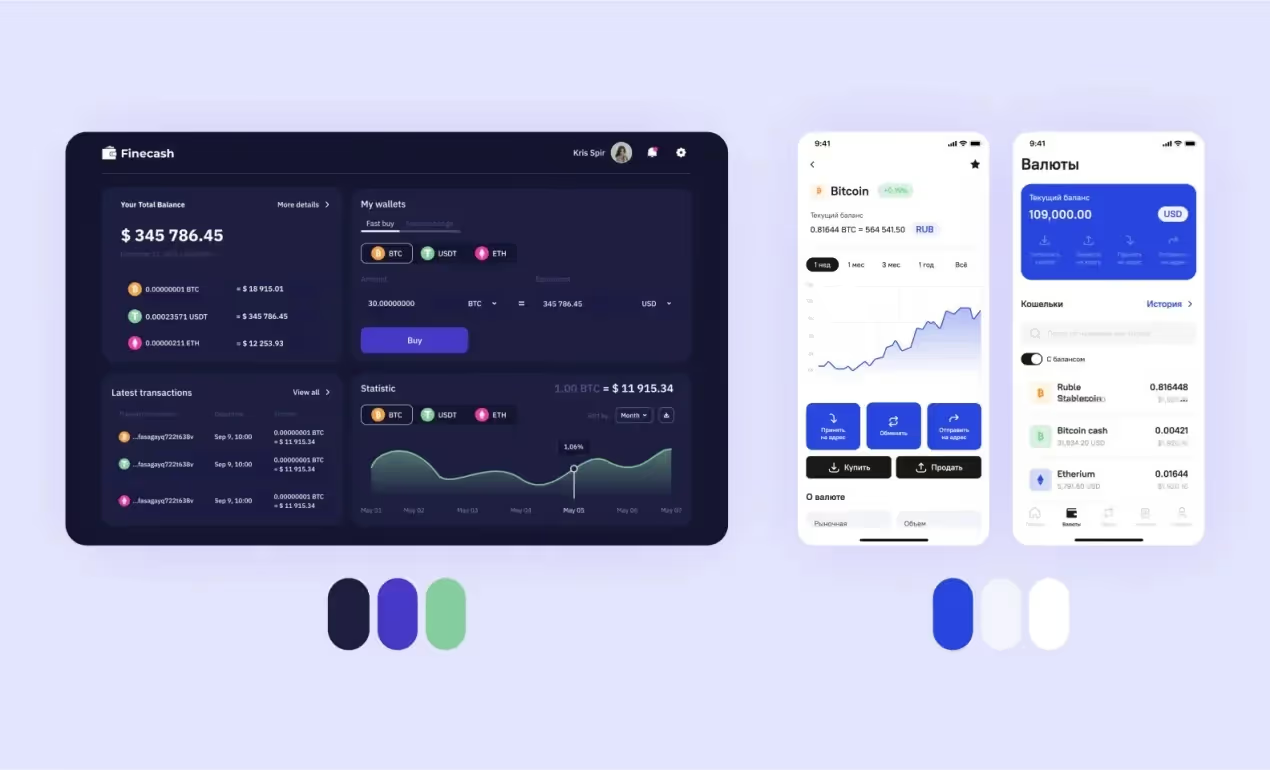
A little while back we got a request from two Japan-based founders. They asked us to design and develop a crypto wallet that would be equally approachable for both newbies and experienced investors. The goal was to create a viable alternative to Metamask, a popular wallet used for storing Ethereum and ERC-20 tokens.
Our clients also chose Metamask as the key reference for the design. We carefully analyzed the rival app and preserved its primary advantages, like the main screen functionality. We also got rid of some of the disadvantages — for example, we removed the complicated navigation and unrequired scroll.
We developed the app with our standard React Native stack. The specifics of the field called for some unusual solutions: for example, the crypto wallet has no backend. Instead, its frontend turns directly to the Ethereum system, which deals with tokens.

If you want to know the average costs of creating a blockchain app, we’ll be glad to tell you the secret. We do not claim that all agencies offer the same price and only speak for ourselves.
Let’s look at the timing and cost of creating a prediction marketplace as one of the crypto blockchain applications that we described earlier. Considering these estimations, you can get the approximate blockchain software development cost.
Here’s how we estimate rates and timeframes of blockchain app development:
Overall, blockchain app development will cost you $93 000.
For more information and an individual offer, please contact us.
We hope this guide has answered all your questions about the development of a blockchain application. Now that you know how to build a blockchain app, you can decide whether this application option is right for you. DApps are in demand because the technology has many advantages, such as transparency, security, autonomy, and cost reduction.
➡️ Should you have any questions, you can contact Purrweb experts for advice. We will be happy to help your idea come true. <a class="blog-modal_opener">Fill out the form</a> and we will contact you.